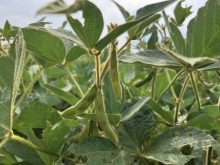A crop protection company is launching a new treatment for white mould and sclerotinia.
Corteva Agriscience last month announced the launch of Viatude, a new fungicide that targets white mould in soybeans for Eastern Canada and sclerotinia in canola in Western Canada.
White mould in Ontario has caused significant yield losses in the past 10 to 15 years. According to the Crop Protection Network, soybean growers lost an estimated 2.1 million bushels to the disease in 2021.
Read Also

Claas brings 1000 Series SP forage harvesters to Canada
In mid-August, Claas unveiled its new line of Jaguar forage harvesters at an event in Visalia, California, deep in the heart of that state’s dairy region.
Why it matters: White mould is a common yield-robbing problem for Ontario soybean growers.
That may place it third behind soybean cyst nematode and sudden death syndrome, but to growers in Eastern Ontario and Western Quebec, white mould is a near-perennial disease in their fields. In Central and Southern Ontario, growers and advisers say severity depends on conditions.
As Dave Kloppenburg notes, white mould causes yield losses as well as reduced plant health.
Farmers may select soybean varieties with enhanced tolerance to the disease, but a fungicide like Viatude, with multiple and effective modes of action, is an important component in an integrated pest management regimen. It combines picoxystrobin (Group 11) and prothioconazole (Group 3) and Corteva’s Onmira active.
“White mould is a significant agronomic issue for farmers and there’s more attention to it,” says Kloppenburg, Corteva’s Eastern portfolio manager for crop protection products.
“In Eastern Ontario and Quebec, it’s consistent and they just plan to manage against it. You can’t afford not to. In Western Ontario, it really depends on the grower and where they’re located, and a lot of it’s based on the agronomic potential of the soils.”
High-yielding environments are generally conducive to white mould and growers can manage those, with varieties, through row spacing and population. In southern Ontario, there are also livestock operations where applied manure creates a moist environment in which white mould can flourish.
“It’s tough because you’re managing for yield but when you’re pushing yield, you’re likely to push conditions for white mould,” says Kloppenburg. “It’s finding a balance, and a fungicide can be part of that management program.”
An endemic problem
Once the disease inoculum for white mould is in the soil, it’s there to stay. As well, Sclerotinia sclerotiorum overwinters. Rotation can reduce the incidence but not eliminate it. For growers who double-crop soybeans after wheat, the risk is even higher.
“The biggest thing with Viatude in our portfolio is that this is a multi-mode-action product,” says Kloppenburg.
“It has two effective modes of action and that’s the change with this product. In our research program, we had a good four years of trials and over that dataset, Viatude was definitely a top performer on white mould suppression and in yield, as well.”
There is a Canada-wide launch for 2023, with interest expected among western Canadian growers, given sclerotinia’s impact on canola, but also with pulses and soybeans. The more hosts for sclerotinia, the greater the chances of building inoculum in the soil.
Timing is key
Kloppenburg cautions against the notion of “chasing” white mould. Growers have to stay in front of it.
That’s where he says soybean’s indeterminate physiology may help. Since the plants don’t flower at the same time, it’s easier to manage for the disease when it becomes a problem.
“It makes timing of a fungicide application critical around the R1.5 to R2 period to protect a lot of the flowers,” says Kloppenburg.
“In many cases if conditions are present, growers will make a second application 10 to 14 days after the first, to cover that total flowering period, to protect the plant.”
– For more on this topic, look for Ralph Pearce’s work in Country Guide.















